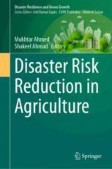Search
Search Results
-
Evaluation of pre- and post-fire flood risk by analytical hierarchy process method: a case study for the 2021 wildfires in Bodrum, Turkey
Wildfires are regarded as one of the devastating natural disturbances to natural ecosystems, and threatening the lives of many species. In July 2021,...

-
Pantanal flood pulse reveals constitutive and plastic features of two wild rice species (Poaceae, Oryzoideae): implications for taxonomy, systematics, and phylogenetics
Annually, the Pantanal flood pulse induces the development of several plant structural responses, such as aerenchyma formation and differential...

-
The river flood pulse, benthic biofilm, and the nutrition of Prochilodus lineatus
Prochilodus lineatus (Valenciennes, 1837) is one of 270 fish species in the Rio Paraná system yet it comprises > 50% of the fish biomass and is the...

-
Branching coral growth and visual health during bleaching and recovery on the central Great Barrier Reef
Coral reefs are under threat from cumulative impacts such as cyclones, crown-of-thorns starfish (COTS) outbreaks and climate-driven coral bleaching...

-
Runnels Reverse Mega-pool Expansion and Improve Marsh Resiliency in the Great Marsh, Massachusetts (USA)
One of the main mechanisms for salt marsh decline across the United States is the inability of the marsh surface to keep pace with sea level rise....

-
Polychlorinated Dibenzo-p-dioxins and Dibenzofurans in the Great Lakes
The history of “dioxin”, PCDD/F, contamination in the Great Lakes is reviewed. Occurrence, geographical distribution, and temporal trends in air,...
-
Costa: Flood Displacement During the 2017 Coastal El Niño in Peru
The research interest in Peru’s western arid coast (Costa) was in the well-being of persons displaced short distances away from their homes by floods...
-
The Identification, Map**, and Management of Seasonal Ponds in Forests of the Great Lakes Region
Seasonal ponds are small, isolated wetlands with variable hydrology, often occurring embedded in upland forests, which provide habitat for amphibians...

-
Flood Control and Air Cleaning Regulatory Ecosystem Services of Agroforestry
Agroforestry (AF) mimics natural forestry where perennial multispecies vegetation and/or livestock is intentionally integrated with agriculture and...
-
Political Ecology, Water Valuations and Feasibility of Water Law Deliberation in the Province of Tierra del Fuego, AIAS (1993–2016)
Social appropriation of water in Patagonia is not only associated with its historical-spatial configuration and the uses of the territory but also...
-
Temporal dynamics of Chironomid (Diptera) diversity under flood–drought pulses in a shallow tropical floodplain lake
The water-level regime is a major determinant of the community structure in river-floodplain systems. Chironomidae is a highly diverse insect family...

-
Natural River Hazards: Their Impacts and Mitigation Techniques
Natural hazards occur due to the interactions between extreme natural events and anthropogenic activity that have the potential to inflict damage,...
-
Zooplankton as an indicator of hydrological connectivity of the main channel and the floodplain in a large river system
The connectivity of the river–floodplain system during floods plays a decisive role in organisms/matter contribution to the ecosystems of large...

-
Thirty-five-year timber harvesting disturbance effects on composition and biomass of tupelo-cypress (Nyssa-Taxodium) forested wetlands, southwest Alabama, USA
Thirty-five years post-harvest, effects of harvest disturbances upon tree composition and aboveground biomass were evaluated in a water-tupelo (Nyssa...

-
Conservation Agriculture a Sustainable Approach for Disaster Risk Reduction in Rice Wheat Crop** System of Pakistan
Globally, climatic vulnerabilities and natural hazards adversely affect crop productivity and food security. Agriculture is an economic activity that...
-
Map** local knowledge through spatial text mining
The ecological knowledge of local residents in a given area is valuable information that can supplement physical environmental data. Like ecosystems,...

-
Methane emission from rice cultivation regulated by soil hydrothermal condition and available carbon and nitrogen under a rice–wheat rotation system
AimSoil available carbon (C) and nitrogen (N) are essential substrates for microbial C and N cycle processes, and under soil hydrothermal conditions,...

-
Propagule pressure and environmental filters related to non-native species success in river-floodplain ecosystems
The flood pulse is the main driving force influencing river floodplain ecosystems. The dominant role of the flood pulse on the success of non-native...

-
Probabilistic modeling of sustainable urban drainage systems
Sustainable Urban Drainage Systems (SUDS) include strategies and solutions for distributed stormwater management and control. They are strongly...

-
Detection and Management of Basal Stem Rot of Oil Palm: Classical to Modern Approaches
Oil palm (Elaeis guineensis Jacq.), also referred as ‘Golden palm’, is the most efficient oil-yielding perennial crop in the world. Unfortunately,...
